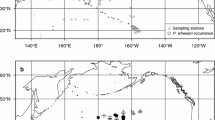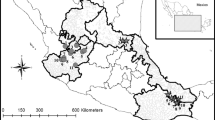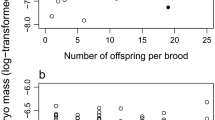Synopsis
Life history variation within the family Embiotocidae is extensive and involves differences in age of first reproduction, fecundity schedules, growth rates, longevity and size of young. Based on maximum reported body lengths, there are three distinct size groups among the family's 23 species. Small species do not exceed 215 mm TL, medium-size species attain 275 to 335 mm TL, and the large species attain 380 to 470 mm TL. The longevity oh surfperches varies from two to ten years, growth is indeterminate, and females of the medium-and large-size groups may delay first reproduction beyond age one. With one exception, all species show increasing length-specific fecundities. The life history characteristics of females differ among the three size groups. Relative to smaller species, the largest species have moderately high fecundity, delayed maturity and long life. Medium-size species have low fecundity, may delay maturity for 1 to 3 years and have intermediate life spans. Small species have generally higher, but variable, fecundity, do not delay maturity, and are short lived. Among the small North American species, the trend in fecundity varies inversely with environmental predictability. Fecundity is highest in the species which occupies highly seasonal freshwater environments. Coastal species produce moderately large broods and species which occupy stable deep water environments produce the smallest broods.
Similar content being viewed by others
References cited
Abe, Y. 1969. Systematics and biology of the two species of embiotocid fishes referred to the genus Ditrema in Japan. Jap. J. Ichthyol. 15: 105–121.
Anderson, R.D. & C.F. Bryan. 1970. Age and growth of three surfperches (Embiotocidae) from Humboldt Bay, California. Trans. Amer. Fish. Soc. 99: 475–482.
Baltz, D.M. 1980. Age-specific reproductive tactics and reproductive effort in the tule perch (Hysterocarpus traski). Ph.D. Dissertation, University of California, Davis. 85 pp.
Baltz, D.M. & E.E. Knight. 1983. Age, growth, and reproductive characteristics and seasonal depth distribution of the spotfin surfperch, Hyperprosopon anale. Calif. Fish. Game (in press).
Baltz, D.M. & E.J. Loudenslager. 1983. Electrophoretic variation among tale perch (Hysterocarpus traski) subspecies. Copeia (in press).
Baltz, D.M. & P.B. Moyle. 1981. Morphometric analysis of tule perch (Hysterocarpus traski) populations in three isolated drainages. Copeia 1981: 305–311.
Baltz, D.M. & P.B. Moyle. 1982. Life history characteristics of tale perch (Hysterocarpus traski) populations in contrasting environments. Env. Biol. Fish. 7: 229–242.
Banerjee, T. 1971. Maturity and fecundity of the white seaperch (Phanerodon furcatus) from Tomales Bay, California. J. Fish. Res. Board Can. 28: 1051–1053.
Benerjee, T. 1973. Age and rate of growth of the white seaperch (Phanerodon furcatus) from Tomales Bay, California. Trans. Amer. Fish. Soc. 102: 448–450.
Behrens, D.W. 1977. Fecundity and reproduction of the viviparous perches Hypsurus caryi (Agassiz) and Embiotoca jacksoni Agassiz. Calif. Fish Game 63: 234–252.
Bennett, D.E. & R.S. Wydoski. 1977. Biology of the redtail surfperch (Amphistichus rhodoterus) from the central Oregon coast. U.S. Fish Wildl. Serv., Tech. Pap. 90: 1–23 .
Carlisle, J.G. Jr., J.W. Schott & N.J. Abramson. 1960. The barred surfperch (Amphistichus argenteus Agassiz) in southern California. Calif. Fish Game, Fish Bull. 109: 1–79.
Churgin, J.C. & S.J. Halminski. 1974. Temperature, salinity, oxygen and phosphate in waters off united States. Vol. III. Eastern North pacific. NOAA National Oceanographic Data Center, Washington, D.C. 260 pp.
Cole, L.C. 1954. The population consequences of life-history phenomena. Quart. Rev. Biol. 29: 103–137.
Darling, J.D.S., M.L. Noble & E. Shaw. 1980. Reproductive strategies in surfperches. I. Multiple insemination in natural populations of shinner perch, Cymatogaster aggregata. Evolution 34: 271–277.
DeMartini, E.E., T.O. Moore & K.M. Plummer. 1983. Reproductive and growth dynamics of Hyperprosopon argenteum (Embiotocidae) near San Diego, California. Env. Biol. Fish. 8: 29–38.
Dorn, P., L. Johnson & C. Darby. 1979. The swimming performance of nine species of common California inshore fishes. Trans. Amer. Fish. Soc. 108: 366–372.
Ebeling, A.W. & R.N. Bray. 1976. Day versus night activity of reef fishes in a kelp forest off Santa Barbara, California. U.S. Fish. Bull. 74: 703–717.
Ebeling, A.W., R.J. Larson, W.S. Alevizon & R.N. Bray. 1980b. Annual variability of reef-fish assemblages in kelp forests off Santa Barbara, California. U.S. Fish. Bull. 78: 361–377.
Feder, H.M., C.H. Turner & C. Limbaugh. 1974. Observations on fishes associated with kelp beds in Southern California. Calif. Dept. Fish Game, Fish Bull. 160: 1–144.
Gaudet, J.J. 1977. Natural drawdown on Lake Naivasha, Kenya, and the formation of papyrus swamps. Aquatic Botany 3: 1–47.
Gnose, C.E. 1967. Ecology of the striped seaperch, Embiotoca lateralis, in Yaquina Bay, Oregon. M. Sc. Thesis, Oregon State University, Corvallis. 53 pp.
Goldberg, S.R. 1978. Reproductive cycle of the white seaperch, Pluanerodon furcatus (Embiotocidae). Copeia 1978: 334–336.
Goldberg, S.R. & W.C. Ticknor, Jr. 1977. Reproductive cycle of the pink surfperch, Zalembius rosaceus (Embiotocidae). U.S. Fish. Bull. 75: 882–884.
Gordon, C.D. 1965. Aspects of the life history of Cymatogaster aggregata Gibbons. M. Sc. Thesis. University British Columbia, Vancouver. 90 pp.
Gotshall, D.W. 1981. Pacific coast inshore fishes. Sea Challengers, Los Osos, California. 96 pp.
Haldorson, L. 1980. Genetic isolation of Channel Islands fish populations: evidence from two embiotocid species. pp. 433–442. In: D.M. Power (ed.) Multidisciplinary Symposium on the California Islands, Santa Barbara Mus. Nat. Hist., Santa Barbara.
Harris, S.W. & W.H. Marshall. 1963. Ecology of water-level manipulations on a northern marsh. Ecology 44: 331–343.
Hassler, T.J. 1970. Environmental influences on early development and year-class strength of northern pike in Lakes Oahe and Sharpe, South Dakota. Trans. Amer. Fish. Soc. 99: 369–375.
Hayase, S. & S. Tanaka. 1980a. Habitat and distribution of three species of embiotocid fishes in the Zostera marina belt of Odawa Bay. Bull. Jap. Soc. Sci. Fish. 46: 955–962.
Hayase, S. & S. Tanaka. 1980b. Growth and reproduction of three species of embiotocid fishes in the Zostera marina belt of Odawa Bay. Bull. Jap. Soc. Sci. Fish. 46: 1089–1096.
Hayase, S. & S. Tanaka 1980c. Feeding ecology of three species of embiotocid fishes in the Zostera marina belt of Odawa Bay. Bull. Jap. Soc. Sci. Fish. 46: 1469–1476.
Hixon, M.A. 1980. Competitive interactions between California reef fishes of the genus Embiotoca. Ecology 61: 918–931.
Horwitz, R.J. 1978. Temporal variability patterns and the distributional patterns of stream fishes. Ecol. Monogr. 48: 307–321.
Howard-Williams, C. 1975. Vegetation changes in a shallow African lake: response of the vegetation to a recent dry period. Hydrobiologia 47: 381–398.
Hubbs, C.L. 1921. The ecology and life-history of Amphigonopterus aurora and of other viviparous perches of California. Biol. Bull. 40: 181–209.
Hubbs, C.L., W.I. Follett & L.J. Dempster. 1979. List of the fishes of California. Occas. Pap. Calif. Acad. Sci. 133: 1–51.
Hynes, H.B.N. 1970. The ecology of running waters. University of Toronto Press, Toronto. 555 pp.
Isaacson, P.A. & D.M. Isaacson. 1966. Notes on the life history of the black perch, Embiotoca jacksoni Agassiz. Trans. Amer. Fish. Soc. 95: 107–109.
Laur, D.R. & A.W. Ebeling. 1983. Predator-prey relationships in surfperches. Env. Biol. Fish. 8: 217–229.
Lea, R.N. 1972. Southern geographical records for four surfperches, family Embiotocidae, with notes on a population resurgence of the sharpnose seaperch. Calif. Fish Game 58: 27–31.
Leopold, L.B., M.G. Wolman & J.P. Miller. 1964. Fluvial processes in geomorphology. W.H. Freeman, San Francisco. 522 pp.
Magnuson, J.J., L.B. Crowder & P.A. Medvick. 1979. Temperature as an ecological resource. Amer. Zool. 19: 331–343.
Miller, D.J. & R.N. Lea. 1972. Guide to the coastal marine fishes of California. U.S. Fish. Bull. 157: 1–235.
Odenweller, D.B. 1975. The life history of the shiner surfperch, Cymatogaster aggregata Gibbons, in Anaheim Bay, California. pp. 107–115. In: E.B. Lane & C.W. Hill (ed.) The Marine Resources of Anaheim Bay, Calif. Dept. Fish Game, Fish Bull. 165.
Quast, J.C. 1968. Some physical aspects of the inshore environment, particularly as it affects kelp-bed fishes. pp. 25–34. In: W.J. North & C.L. Hubbs (ed.) Utilization of Kelp-bed Resources in Southern California. Calif. Dept. Fish Game. Fish. Bull. 139.
Robins, C.R., R.M. Bailey, C.E. Bond, J.R. Brooker, E.A. Lachner, R.N. Lea & W.B. Scott. 1980. A list of common and scientific names of fishes from the United States and Canada. Amer. Fish. Soc. Spec. Publ. No. 12. 174 pp.
Roff, D.A. 1981. Reproductive uncertainty and the evolution of iteroparity: why don't flatfish put all their eggs in one basket? Can. J. Fish. Aquat. Sci. 38: 968–977.
Rosenthal, R.J., W.D. Clarke & P.K. Dayton. 1974. Ecology and natural history of a stand of giant kelp, Macrocystis pyrifera, off Del Mar, California. U.S. Fish. Bull. 72: 670–684.
Schrode, J.B., K.E. Zerba & J.S. Stephens, Jr. 1982. Ecological significance of temperature tolerance and preference of some inshore California fishes. Trans. Amer. Fish. Soc. 111: 45–51.
Shaw, E., J. Allen & R. Stone. 1974. Notes on collection of shiner perch, Cymatogaster aggregata, in Bodega Harbor, California. Calif. Fish Game 60: 15–22.
SIO. 1978–1981. Data report, surface water temperatures at shore stations, U.S. West Coast. Scripps Inst. Oceanog. Refs. 78-5, 78-16, 79-9, 80-11 and 81-30.
Smith, J.G. 1964. Notes on the life history and a description of the sharpnose seaperch. Phanerodon atripes (Jordan and Gilbert). Calif. Fish Game 50: 42–47.
Stearns, S.C. 1980. A new view of life-history evolution. Oikos 35: 266–281.
Swedberg, S.E. 1966. Age-fecundity relationships in the striped seaperch Embiotoca lateralis from Yaquina Bay, Oregon. M. Sc. Thesis. Oregon State University, Corvallis. 41 pp.
Terry, C.B. & J.S. Stephens, Jr. 1976. A study of the orientation of selected embiotocid fishes to depth and shifting seasonal vertical temperature gradients. Bull. So. Calif. Acad. Sci. 75: 170–183.
Valentine, J.W. 1973. Evolutionary paleoecology of the marine biosphere. Prentice-Hall, Englewood Cliffs. 472 pp.
Wares, P.G. 1971. Biology of the pile perch, Rhacochilus vacca in Yaquina Bay, Oregon. U.S. Fish. Wildl. Serv., Tech. Pap. 57: 1–21.
Warner, R.R. & R.K. Harlan. 1982. Sperm competition and sperm storage as determinants of sexual dimorphism in the dwarf surfperch, Micrometrus minimus. Evolution 36: 44–55.
Westlake, D.F. 1975. Macrophytes. pp. 106–128. In: B.A. Whitton (ed.) River ecology, Univ. Calif. Press, Berkeley.
Wilson, D.C. & R.E. Millemann. 1969. Relationships of female age and size to embryo number and size in the shiner perch, Cymmogaster aggregata. J. Fish. Res. Board Canada 26: 2339–2344.
Wydoski, R.S. 1969. Occurrence of the spotfin surfperch in Oregon waters. Calif. Fish Game 55: 335.
Wydoski, R.S. & D.E. Bennett. 1973. Contributions to the life history of the silver surfperch (Hyperprosopoa ellipticum) from the Oregon coast. Calif. Fish Game 59: 178–190.
Yamane, S. 1964. A revisional study of the surf-fishes, referable to the genus Ditrema. Bull. Misaki Mar. Biol. Inst. Kyoto Univer. 5: 1–10.
Author information
Authors and Affiliations
Rights and permissions
About this article
Cite this article
Baltz, D.M. Life history variation among female surfperches (Perciformes: Embiotocidae). Environ Biol Fish 10, 159–171 (1984). https://doi.org/10.1007/BF00001123
Received:
Accepted:
Issue Date:
DOI: https://doi.org/10.1007/BF00001123




